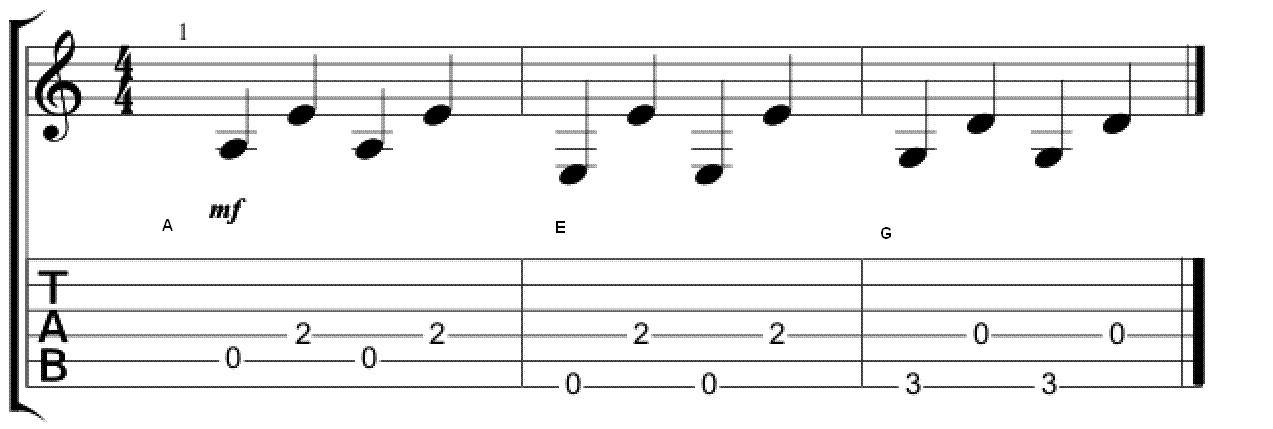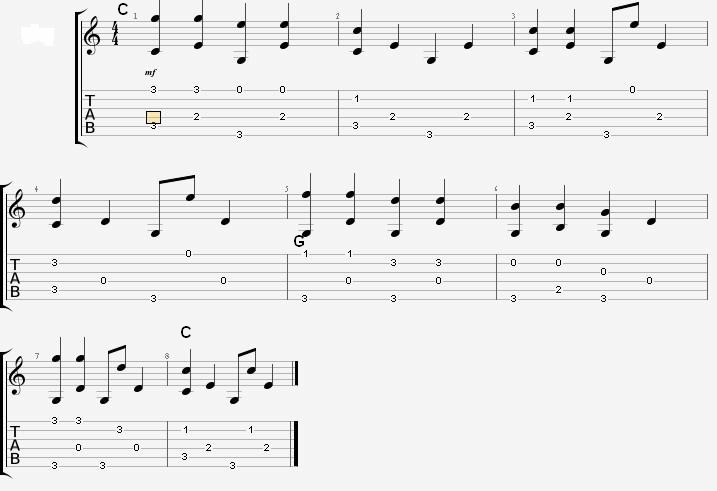
How To Play Great Fingerpicking Guitar--Even If You're All Thumbs!
Chapter 4
GETTING STARTED
Finger-style guitar is self contained--you don't need anyone else to create a complete "sound": Bass line, melody, rhythm, and lead. One might say that it helps to use what we New Yorkers call the "Joy Of Schizophrenia"--doing at least two things at once. You know--what New York shrinks call "harmless Type A types."
Anybody out there talk on the phone and cook dinner at the same time? (Or even EAT dinner while on the phone?) Or try to make breakfast while shaving? Don't be ashamed...you have the makings of a Great Fingerstyle Guitarist!
THE BASS The foundation of great fingerpicking style is a STEADY RIGHT THUMB. Yep--a right thumb that just won't quit. The right thumb is your "rhythm section". It's your combination bass player and drummer. It punches out the bass line like a metronome.
If you're a nervous desk-tapper during idle moments, you can put that habit to good use. Next time you're killing time, tap your right thumb slowly and evenly, as if your thumb was a ticking clock.
Since your right thumb is going to play the bass, it would be a good idea if we knew where the bass was!
The bass strings are the FATTEST three strings--the one closest to your nose (most of you).
Hear it Bass Lines
Now I know this may seem (yawn) boring, but humor me--Let's try
some bass lines over chords. Look at the example below:

Repeat each measure overand over, to "get the flow"
Note the chord your left hand will finger is printed above the measure. Hold that chord, and use your Right Thumb to play those notes under the chord symbol. Almost all of them will be on the bass (fatter) strings.
Yes, your left hand does very little--except with the C chord bass, where I've given you TWO different bass lines.
(C) Easy Bassline (C) Harder Bassline

Repeat each measure over and over, by itself
The second bass line is better, a little trickier. Your Left RING finger will have to move on the THIRD beat of every C measure, to get to the 6th string (and later to go back to the 5th string beginning the next measure). Don't Panic. Remember, if old burnt-out Southern sharecroppers could do this after a long day in the fields, you too can handle it.Try these basses SLOWLY and EVENLY until you memorize them. Now we'll add melody above them.
Ooops! Can you combine the basses with steady patterns for the Right index and middle fingers? Well, it all depends. Continue the "schizophrenic separation" of playing the steady, four-beat-per-measure Bass.
Now add just two treble notes, as in this Pattern #1:
 What's this?
Play the Second bass note TOGETHER with the first string (using your
right middle). Play that first string again on the SECOND HALF of the
third beat (huh?).
What's this?
Play the Second bass note TOGETHER with the first string (using your
right middle). Play that first string again on the SECOND HALF of the
third beat (huh?).
That is, play the 1st string again after the third--but BEFORE the fourth--bass note.
Then try the other chord G using the same Pattern #1. In fact, once you learn the pattern, try it with any chord.
Once again, play each measure several times, to create a "smooth flow" of notes.
Now try Pattern #1
Same concept, more treble notes:

Again, play each measure over and over several times, before going on to the next chord. This will help you memorize the feel of the pattern, so you won't always have to read it.
This time, play your right middle ON the FIRST beat! Then right Index on the OFF-beat, then right Middle again ON the SECOND beat, and so on. The right middle plays only the 1st string, and the right index plays the 2nd string. Thank goodness the Fourth Beat is only Bass.
Keep practicing it until the bass lines are memorized, and follow
like little footsteps,
REGULAR and EVEN. Remember, folks
used to dance to this style!
Pattern #3, the pattern that made Peter Paul and Mary famous:
Now the treble note is ON the first beat, and OFF the second and third beats (NOTE: 7”Off" means in-between the bass notes--thus in this pattern the treble note is in-between the second and third, and third and fourth, beats). Come on, if Peter and Paul did it, how hard can this be?
When in doubt, check the sound link above the pattern, or borrow a copy of "Puff the Magic Dragon".
Now that you've sampled the rhythms of fingerpicking, we can move onto playing a melody--not just rhythm accompaniment pattern.
Let's try a basic two-voice tune I learned from an old Mance Lipscomb album. It's a famous Southern play tune, we've got to start somewhere, and...well, it's a lot better than "Row Row Your Boat," or "Skip To My Lou", or....
I'd like you to try TWO versions, with identical melodies.
BUT: the first version has a simpler bass line for the C chord.
Try it first!
Remember:
play the notes stemmed together vertically (the ones on top of each other) at the SAME TIME.
Sometimes the bass will sound alone, and sometimes with the melody. But at all times the bass is your "point of reference."
Note that your left pinky has to reach for melody notes (such as the opening G on the 1st string).
You'll be using your left pinky a lot, as well as moving other left hand fingers on and off the chords, to sound the right notes (even if they're not in the chords).
Once again, if downtrodden Souther migrant workers could play this, etc.

Now try Version #2, with the full THREE note C chord bass line.
Same treble, but the bass isn't so "base." Much better, eh!

|
Back to the Table Of Contents |
Trouble reading the Tab?: Tablature Help Here |
More info/contact Andy: www.andypolon.com